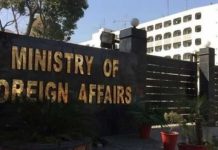Abdul Samad Mugheri Larkana
Pakistan is running out of the fresh water at an alarming rate. Pakistan is currently facing an acute water shortage which is likely to dry havoc in country in future. In Pakistan, The signs of water stress are ubiquitous in the form of water scarcity, resource depletion and contamination. The Islamic republic of Pakistan is running out of fresh water at an alarming rate, and authorities anticipate that is likely to suffer a shortage of 31 million acre-feet (MAF) of water by 2026.
The shortfall will be for a devastating country with an agriculture-based economy, as our dear country the Islamic republic of Pakistan is. All of us know that Approximately 72% Percent of Pakistan’s population is directly or indirectly associated by agriculture, that accounts for 26 percent of its gross domestic product (GDP). In Pakistan, The majority of land is irrigated after accounting for ground and rainwater with fresh water from the IBIS. The IBIS is fed through two important dams including Tarbela and Mangla, which since construction have lost storage capacity because of enormous silt deposition. Both reservoirs are already hitting a dead level and are unlikely to carry further the required flow for the summer crops.
The catastrophe implicates the country’s incompetent leadership, and its inept administration and poor management of available natural water resources. This has made our country Pakistan vulnerable to long draught spells and extreme floods. The climate-change water crisis not only poses a threat to summer cropping season but has also adversely affected the generation of hydroelectricity. Our dear country Pakistan is storing less water among the available surface flows due to lack of significant storage.
And given the severely irregular water availability in rivers, The lack of adequate storage at all levels make it practically impossible to stock the priceless resource reasonably. However, the country receives a significant amount of water from the monsoon spells that, If stored properly, could provide with a sustainable irrigation system. Due to fewer water releases from the dams, Farmers largely depend on groundwater. This puts extra pressure on the aquifers. The majority of agricultural production depends on underground water, which is not efficiently utilized causing the water table to plummet at an alarming rate. Farming and urban communities pup for more amounts of groundwater than is replenished naturally into the aquifers. With nearly 3 to 4 MAF shortfall of groundwater discharge annually, the aquifers are receding at an alarming rate.
Moreover, a 2015 NASA-led study confirmed that the Indian basin aquifer is among the most overstressed and rapidly depleting systems in the world. Rainwater harvesting and partially treated sewage Creeks for groundwater recharge are two valuable solutions but the country is far from adopting these on a large scale. Furthermore, the farming community is wasting a tremendous amount of fresh water by using outdated flood irrigation methods. Nearly 96% of fresh water is utilized for irrigation, and yet the country is receiving a lower per acre crop production when compared to India and china in region. The most crucial next step should be to build new reservoirs are equally vital to meet the requirement of agriculture, rapid urbanization, population growth, food insecurity and growing water demand of the industry. The recently approved national water policy must be implemented both in letter and in spirit for efficient water resource management. Furthermore, commissions must be set up to monitor the efficient water resources management at all levels frequently and to offer timely recommendations.
It is the challenge for the state to save water not only for agriculture but also for human consumption and to meet the rising water demand in other social and economic sectors. This demands improved water governance, management and investment in scientific knowledge, all of which entail commitment and resources. It is a time for significant action.

















